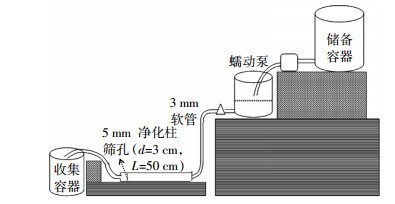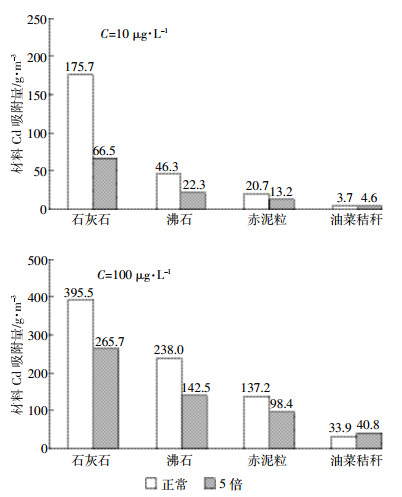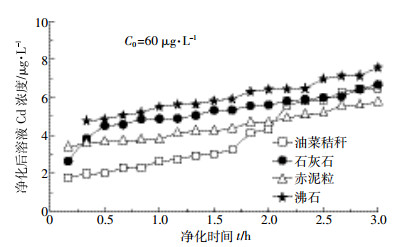文章信息
- 和君强, 李菊梅, 马义兵, 纪雄辉, 赵会薇
- HE Jun-qiang, LI Ju-mei, MA Yi-bing, JI Xiong-hui, ZHAO Hui-wei
- 四种材料对灌溉水中镉净化性能的比较
- Performance of selected materials for the purification of cadmium contaminated irrigation water
- 农业环境科学学报, 2016, 35(10): 1984-1991
- Journal of Agro-Environment Science, 2016, 35(10): 1984-1991
- http://dx.doi.org/10.11654/jaes.2016-0363
文章历史
- 收稿日期: 2016-03-19
2. 湖南省农业科学院土壤肥料研究所, 长沙 410125 ;
3. 农业部长江中游平原农业环境重点实验室, 长沙 410125 ;
4. 国家半干旱农业工程技术研究中心, 石家庄 050051
2. Institute of Soil and Fertilizer, Hunan Academy of Agricultural Sciences, Changsha 410125, China ;
3. Ministry of Agriculture Key Laboratory of Agriculture Environment in Middle Reach Plain of Yangtze River, Changsha 410125, China ;
4. The Semi-arid Agriculture Science and Technology Research Center of China, Shijiazhuang 050051, China
Cd移动性较强,易富集并通过食物链危害人体健康[1],风险系数远高于其他重金属[2]。我国地表水Cd生态风险不容忽视,二次污染风险较高[3]。据研究,全国七大水系大部分样点表层沉积物Cd潜在生态危害系数分布于强(80~160)至极强(≥160),其中珠江(Eri=1755)、海河(Eri=583)和淮河(Eri=290)较严峻[4]。珠江河口断面(N=32)水相Cd平均浓度12.80 μg·L-1[5];湘江总体水质呈恶化态势,干流及主要支流断面(N=36)Cd超标比率达22%[6]。天然地表水为农用灌溉水主要来源之一,据统计,我国灌溉水每年携带约30 t Cd进入农田[7],土壤中Cd含量与灌溉水Cd浓度成正比[8-9],稻米Cd含量与土壤Cd含量呈显著正相关[10],含Cd灌溉水大定额长期使用已造成稻田土壤Cd累积并引发了农田生态系统环境风险[11],污染灌溉水Cd快速净化十分必要。
水体Cd污染应急处置中常采用烧碱、石灰、聚合氯化铝等物质将Cd沉淀分离。常规水体Cd净化技术主要有吸附法、絮凝/螯合法和生物法,其中吸附法由于环保高效、易操作而成为灌溉水Cd快速净化首选方法之一,其关键在于低成本材料优选[12]。近年来,研究较多的Cd吸附材料主要有天然矿物如沸石[13-16]、膨润土[17-20]、累托石[21]等,工业废弃物如赤泥[22-23]、油页岩灰渣[24]等,农业废弃物如甘蔗渣[25]等。一方面,大多数材料水稳定差、粒度较小,或因巯基等改性材料成本较高;另一方面,结合农田灌溉水应用实际,要求工艺简便高效,且净化过程中不对灌溉速度造成影响。这就要求滤材结构粒径大、透水性好,且在水中有一定稳定性和机械强度,但当前关于净Cd材料的研究多集中于粉末状材料Cd吸附特征及机理,难以契合应用实际。基于此,本研究通过等温吸附实验和动态模拟实验,初步探讨了课题组前期筛选的4种特征材料对灌水Cd吸附性能,吸附过程中pH、电导率(EC)变化及吸附机理,旨在为材料进一步应用提供理论基础。
1 材料与方法 1.1 供试材料和装置4种材料(石灰石、沸石、赤泥粒和油菜秸秆)基本性质见表 1,重金属含量均低于农田土壤环境质量(GB 15618-2008)二级标准和有机肥料标准(NY 525-2011),具有低浸出毒性。赤泥主要化学性质为:pH 13.1、含CaO 38.8%、SiO2 22.0%、Fe2O3 7.7%、Al2O3 4.7%、K2O 0.2%,石灰石和沸石主要化学组分均为CaCO3。赤泥粒制备方法:固体组分质量配比为赤泥(60目)100~120份、硅藻土15~20份,粘结剂为体积百分浓度30%水性聚氨酯-丙烯酸酯(PUA)复合的乳液水溶液,固体组分与粘结剂比例100 g:20 mL,混均并充分熟化,造粒并将胚体放于阴暗处稳定2 h,110 ℃烘烤3 h,筛分备用。动态吸附采用装置厢式(图 1)。

|
| 图 1 动态模拟试验装置示意图 Figure 1 The device for dynamic test purifying Cd polluted water |
为比较4种材料对灌溉水Cd及离子强度对材料Cd吸附性能的影响,本研究设两个不同离子强度水平:正常(EC=0.79 mS·cm-1,离子组分及强度模拟自然河水[26])和5倍(EC=3.43 mS·cm-1,5倍自然河水离子强度),控制pH为6.0[27]。本试验侧重探讨平衡液Cd浓度区间0~100 μg·L-1的材料Cd吸附容量,根据预试验不同材料表现,设7个Cd浓度梯度,其中石灰石、沸石吸附试验的Cd浓度梯度为0、10、20、30、45、60、75 mg·L-1,赤泥粒和油菜秸秆Cd浓度梯度为0、1.5、3.0、4.5、7.5、12.0、18.0 mg·L-1,共计56个处理,3次重复。具体操作方法[28]为:控制试验温度25 ℃,根据材料容重换算等体积(15 cm3)材料质量,精确(0.001)称取材料于100 mL离心管中,加入不同Cd浓度溶液50 mL,恒温低速(60 r·min-1)振荡48 h,3000 r·min-1高速离心25 min,上清液过0.45 mm滤膜,测定溶液pH、EC及Cd浓度。比较等体积不同材料Cd吸附性能,材料对Cd吸附量Qv(g·m-3)由Cd加入浓度(C',mg·L-1)与平衡液Cd浓度(C,μg·L-1)换算得到(公式1)。
 (1)
(1) 应用Langmuir、Freundlich和Tempkin方程分别表征材料Cd等温吸附过程。表达式为C/Q=1/K1Qm+C/Qm、Q=K2C1/n和Q=a+blnC,式中Q为材料对Cd吸附量,C为平衡液Cd浓度,K1为吸附平衡常数,Qm为材料对Cd最大吸附量,K2、n、a和b均为系数。
1.2.2 动态吸附实验为研究一定水流推进速度下材料对水中微量Cd的动态吸附特征,于图 1所示净化柱中分别填充长为20 cm的4种材料,调节过水量5.0 L··min-1,储备容器中溶液Cd浓度60 μg·L-1,pH、EC和离子组分同1.2.1,净化时长3 h,每10 min收集流出液并测定Cd浓度。应用BDST模型表征材料Cd动态吸附特征,该模型普遍应用于多孔介质材料渗流吸附过程的表征,可预测一定渗流速度、填层长度、溶质浓度等操作条件下吸附操作时间[7, 29-30](公式2)。一定时间内材料对Cd吸附量Mad可由穿透曲线与直线C=C0所围成的积分面积推算(公式3)。
 (2)
(2)  (3)
(3) 式中:C0为模拟溶液初始Cd浓度,mg·L-1;C为出水Cd浓度,mg·L-1;Kb为动态吸附速率常数,其值越小表示材料越容易固持Cd离子,L·mg-1·h-1;N0为最大吸附容量,mg·dm-3;z为材料填充长度,cm;v为流速,cm·h-1;t为净化时间,h;Q为进水流量,L·h-1。
1.3 测定指标及方法材料重金属含量采用微波消解(美国CEM Mars 5微波消解仪),其中Cr、Cu、Zn、Cd、Pb采用原子吸收光谱仪(AAS,德国耶拿ZEEnit 700P)测定,Hg、As采用双道原子荧光光度计(AFS-920,北京吉天仪器有限公司)测定;溶液中Cd浓度采用ICP-MS 2000(江苏天瑞仪器股份有限公司)测定;pH用酸度计法(PHS-3C,上海康仪仪器有限公司);EC用电导率仪(FE30,瑞士梅特勒托利多)测定;材料容重采用环刀法,有效孔隙度参照MT 41-1987;流体流量采用流量计(HY-LUGB,江苏宏仪自动化仪表有限公司)测定。
1.4 数据分析采用Excel和SAS进行数据统计,用单变量分析(ANOVA)LSD法检测差异显著性,用Origin 8.5作图。
2 结果与分析 2.1 4种材料对镉等温吸附曲线的比较吸附材料与溶液Cd吸附达到平衡时,材料Cd吸附量均随着平衡液Cd浓度增加而提高(图 2),但不同材料吸附量差异较大,且受离子强度影响显著(图 3)。平衡液Cd浓度区间(0~100 μg·L-1)内,不同材料Cd吸附能力顺序为:石灰石>沸石>赤泥粒>油菜秸秆。离子强度对石灰石和沸石对Cd吸附有显著影响,且影响随平衡液浓度增加逐渐扩大,但是离子强度对油菜秸秆、赤泥对Cd吸附的影响较小。平衡溶液Cd浓度为10 μg·L-1(农用灌溉水质标准GB 5084-2005)时,在背景离子强度EC=0.79 mS·cm-1(EC=3.43 mS·cm-1)溶液,材料对Cd吸附量依次为石灰石175.7 g·m-3(66.5 g·m-3)>沸石46.2 g·m-3(22.3 g·m-3)>赤泥粒20.7 g·m-3(13.2 g·m-3)>油菜秸秆3.7 g·m-3(4.6 g·m-3)。吸附平衡溶液Cd浓度100 μg·L-1(污水综合排放标准GB 8978-1996)时,正常离子强度下,石灰石、沸石、赤泥粒和油菜秸秆对Cd的吸附量分别为395.5、238.0、137.2、33.9 g·m-3;5倍离子强度下,石灰石和沸石Cd平衡吸附量分别为265.7、142.5 g·m-3,而赤泥粒和油菜秸秆Cd的吸附量分别为98.4、40.8 g·m-3。

|
| 图 2 两种离子强度水平下不同材料Cd等温吸附曲线 Figure 2 Cd isotherm adsorption curves of selected materials at different ion levels |

|
| 图 3 不同材料对溶液中低浓度Cd的等温吸附容量比较 Figure 3 Equilibrium adsorption capacity of selected materials for low concentration Cd in solution |
4种材料对Cd等温吸附过程引起了溶液pH值和EC值的变化(图 4),特别是赤泥粒平均提升溶液pH值4.7个单位,提升溶液EC值17.2 mS·cm-1。石灰石、沸石和油菜秸秆对溶液pH和EC的影响显著弱于赤泥粒,石灰石和沸石分别平均提升溶液pH值1.4、1.3个单位,二者对溶液EC值影响微弱,吸附过程中EC(≈0.21 mS·cm-1)变化不显著。油菜秸秆平均提升溶液pH 0.86个单位和EC 3.6 mS·cm-1,且受离子强度影响不显著。

|
| 图 4 不同材料等温吸附过程中溶液pH和EC值变化 Figure 4 Changes of pH and conductivity in the equilibrium adsorption process for selected materials |
等温吸附方程的决定系数越大,表征的吸附过程就越占优势(表 2)。除沸石外,两种离子水平下均表现为R2>R3>R1,表明3种材料对水体中Cd的吸附以非均相表面多层吸附或化学吸附为主,其中油菜秸秆R1普遍较小,表面单层吸附不占优势。沸石3种机理都占优势,但随着溶液离子强度增大R2减小,R1和R3增大,表面多层吸附逐渐趋于单层吸附和化学吸附。低离子水平下,Mv和m均表现为石灰石>沸石>赤泥粒>油菜秸秆,K1表现为油菜秸秆>石灰石>沸石>赤泥粒,n表现为石灰石>沸石>赤泥粒>油菜秸秆。离子强度扩大5倍,石灰石、沸石和赤泥粒参数Mv、m、K1均不同程度降低,但油菜秸秆确发生小幅增加。Mv降低幅度为油菜秸秆-27.2 g·m-3<赤泥粒18.7 g·m-3<石灰石61.1 g·m-3<沸石86.4 g·m-3。
 |
实际净化过程中材料对溶液中Cd的吸附是动态过程,在实验水头和Cd初始浓度保持不变的情况下,不同材料对Cd动态吸附曲线显示(图 5),净化后溶液Cd浓度随时间t的延长而增加。这表明材料净化功能的衰减,但3 h净化过程中水中Cd浓度始终<10 μg·L-1,溶液Cd净化效率90.2%~93.8%。赤泥粒Cd净化功能较等温吸附显著提升,下文将详细阐释;油菜秸秆前期Cd净化效率较高,但随净化时间延长衰减速率远大于其他三类材料。4种材料对Cd动态吸附曲线BDST模型拟合均达到了95%置信区间(表 3),材料Cd动态吸附速率常数Kb表现为油菜秸秆>赤泥粒>石灰石>沸石,Cd动态吸附容量N0表现为赤泥粒1776 g·m-3>石灰石1767 g·m-3>沸石1704 g·m-3>油菜秸秆837 g·m-3。

|
| 图 5 一定水流推进速度下材料Cd动态吸附曲线 Figure 5 The Cd dynamic adsorption curve at a certain velocity of flow |
 |
赤泥作为吸附剂去除水体重金属离子效果显著[31],经造粒仍保留了较强Cd快速吸附能力,主要机理是赤泥具有强碱性和较高比表面及荷质比,可通过表面沉淀和物理化学吸附重金属离子[32-34]。Cd在碱性条件下可形成高度稳定的Cd(OH)2,有效沉淀pH范围9.5~12.5[35],且pH=8.5时,Cd可与Fe(OH)2或Al(OH)3发生共沉淀;此外赤泥富含Fe、Mn氧化物,可专性吸附重金属。赤泥Cd吸附量随离子强度增大趋于降低[36],与本研究等温吸附过程一致;赤泥对Cd吸附包含外层和非专性吸附(约占65%)以及专性吸附(约35%)两种不同的吸附过程[37],也可解释本研究中平衡吸附R2>R3>R1,且不同离子强度下ΔMv相对较小。赤泥粒Cd动态吸附性能显著优于等温吸附,可能由于等温吸附过程中溶液pH及EC大幅增加,对赤泥Cd外层和非专性吸附过程产生影响,使Cd吸附速率和容量减低,而动态吸附过程中溶液组分变化较小。
3.2 油菜秸秆对水中Cd的吸附特征一些十字花科植物秸秆如油菜秸秆中巯基化合物含量丰富,能与Cd发生螯合作用[38-41],常作为土壤重金属Cd钝化剂[36, 42]。等温和动态吸附结果均显示,油菜秸秆对水中Cd有较强的吸附作用力,但Cd吸附容量显著低于其他材料,Cd动态吸附效率随着净化时间的延长衰减明显。油菜秸秆Cd吸附机理趋于非均相表面多层吸附或化学吸附,Cd吸附量受溶液离子强度影响较小,固持的Cd不易解离。
3.3 石灰石、沸石对水中Cd的吸附特征石灰常与烧碱、聚合氯化铝一起作为Cd污染水应急处置试剂。重金属Cd可与碳酸钙发生共沉淀降低土壤中重金属的移动性[43]。沸石是碱金属或碱土金属的水化铝硅酸盐晶体,含有大量的三维晶体结构、很强的离子交换能力及独特的分子结构(具有骨架状的特殊构造),可通过离子交换吸附和专性吸附降低土壤中重金属的有效性。平衡吸附实验结果显示,石灰石对溶液中Cd的吸附过程涵盖表面单层吸附、多分子层吸附和化学吸附,Cd吸附容量较大且吸附相对稳固。较低离子水平下沸石以多分子层吸附和化学吸附为主,随着离子强度增加非均相表面多层吸附过程减弱,逐渐趋于单层吸附和化学吸附。
3.4 4种材料经济及环境效益评价赤泥是以铝土矿为原料生产氧化铝过程中产生的极细颗粒强碱性固体尾渣,每生产1 t氧化铝,大约产生赤泥0.8~1.5 t,我国赤泥储量丰富且属买方市场。水性聚氨酯-丙烯酸酯乳液是以水替代有机溶剂作为分散介质的改性高分子材料,具有硬度高、耐磨损及使用安全、无毒、无环境污染等优点。油菜秸秆为农业废弃物,来源广、成本相对较低。石灰石、沸石为两种常见的天然、无机微孔矿物,本研究原材料来自采石场或建筑行业废弃的碎石尾料,实现了工农业等废置物的资源化利用。本研究探讨了4种大粒径水稳性材料在单一重金属Cd污染体系中对水中较低浓度Cd的平衡和动态净化能力,拟筛选并应用于农田Cd污染灌溉水的应急处理。本研究未对4种材料对Cd的吸附达到饱和点时做重复利用和无害化处理研究,后续将做深入探讨。
4 结论(1)4种材料均对灌溉水中Cd有一定净化能力。等温吸附过程中材料Cd吸附量表现为石灰石>沸石>赤泥粒>油菜秸秆;Cd动态吸附容量则为赤泥粒>石灰石>沸石>油菜秸秆。材料对Cd吸附过程中提升溶液pH能力表现为赤泥粒>>石灰石和沸石>油菜秸秆。
(2)溶液离子强度对石灰石和沸石对Cd吸附有显著影响,且随平衡液Cd浓度增加影响扩大,但是离子强度对油菜秸秆、赤泥粒对Cd吸附的影响较小。油菜秸秆对水中Cd吸附作用力强,但吸附容量相对较低,Cd动态净化效率随时间衰减显著。
| [1] | McLaughlin M J, Singh B R E. Cadmium in soils and plants[M]. Dordrecht: Kluwer Academic, 1999 . |
| [2] | 魏俊峰, 吴大清, 彭金莲, 等. 污染沉积物中重金属的释放及其动力学[J]. 生态环境 , 2003, 12 (2) : 127–130. WEI Jun-feng, WU Da-qing, PENG Jin-lian, et al. Release and kinetics of heavy metals from the contaminated sediments[J]. Ecology and Environment Sciences , 2003, 12 (2) : 127–130. |
| [3] | Segura R, Arancibia V, Zuniga M C, et al. Distribution of copper, zinc, lead and cadmium concentrations in stream sediments from the Mapocho River in Santiago, Chile[J]. Journal of Geochemical Exploration , 2006, 91 (1-3) : 71–80. DOI:10.1016/j.gexplo.2006.03.003 |
| [4] | 朱青青, 王中良. 中国主要水系沉积物中重金属分布特征及来源分析[J]. 地球与环境 , 2012, 40 (3) : 305–313. ZHU Qing-qing, WANG Zhong-liang. Distribution characteristics and source analysis of heavy metals in sediments of the main river systems in China[J]. Earth and Environment , 2012, 40 (3) : 305–313. |
| [5] | 胡锡永, 赖子尼, 赵元凤, 等. 珠江河口重金属镉的含量与分布的季节特征[J]. 中国水产科学 , 2011, 18 (3) : 629–635. HU Xi-yong, LAI Zi-ni, ZHAO Yuan-feng, et al. Seasonal characteristics of cadmium content and distribution in Pearl River estuary[J]. Journal of Fishery Sciences of China , 2011, 18 (3) : 629–635. |
| [6] | 刘耀驰, 高栗, 李志光, 等. 湘江重金属污染现状、污染原因分析与对策探讨[J]. 环境保护科学 , 2010, 36 (4) : 26–29. LIU Yao-chi, GAO Li, LI Zhi-guang, et al. Analysis on heavy metals pollution status and reasons in Xiangjiang River and discussion on its countermeasures[J]. Environ Protect Sci , 2010, 36 (4) : 26–29. |
| [7] | Luo L, Ma C Y, Ma Y B, et al. New insights into the sorption mechanism of cadmium on red mud[J]. Environmental Pollution , 2011, 159 (5) : 1108–1113. DOI:10.1016/j.envpol.2011.02.019 |
| [8] | 李玉清, 周雪梅, 姜国辉, 等. 含镉水灌溉对水稻产量和品质的影响[J]. 灌溉排水学报 , 2012, 31 (4) : 120–123. LI Yu-qing, ZHOU Xue-mei, JIANG Guo-hui, et al. Influence of irrigation with different concentrations of cadmium solution on rice yield and quality[J]. Journal of Irrigation and Drainage , 2012, 31 (4) : 120–123. |
| [9] | 刘韬, 郭淑满. 污水灌溉对沈阳市农田土壤中重金属含量的影响[J]. 环境保护科学 , 2003, 29 (117) : 51–52. LIU Tao, GUO Shu-man. Effect of waste irrigation on heavy metal content in farm soil in Shenyang[J]. Environmental Protection Science , 2003, 29 (117) : 51–52. |
| [10] | 彭华, 戴金鹏, 纪雄辉, 等. 稻田土壤与稻米中的镉含量关系初探[J]. 湖南农业科学 , 2013 (7) : 68–72. PENG Hua, DAI Jin-peng, JI Xiong-hui, et al. Correlation between cadmium content in paddy soil and in rice[J]. Hunan Agricultural Sciences , 2013 (7) : 68–72. |
| [11] | 陈涛, 常庆瑞, 刘京, 等. 长期污灌农田土壤重金属污染及潜在环境风险评价[J]. 农业环境科学学报 , 2012, 31 (11) : 2152–2159. CHEN Tao, CHANG Qing-rui, LIU Jing, et al. Pollution and potential environment risk assessment of soil heavy metals in sewage irrigation area.[J]. Journal of Agro-Environment Science , 2012, 31 (11) : 2152–2159. |
| [12] | Altundogan H S, Altundogan S, Tumen F, et al. Arsenic adsorption from aqueous solutions by activated red mud[J]. Waste Management , 2002, 22 (3) : 357–363. DOI:10.1016/S0956-053X(01)00041-1 |
| [13] | 胡克伟, 贾冬艳, 颜丽, 等. 盐饱和沸石对Cd2+的吸附特性研究[J]. 土壤通报 , 2013, 44 (6) : 1418–1422. HU Ke-wei, JIA Dong-yan, YAN Li, et al. Effect of zeolite saturated with salt on the adsorption of Cd2+[J]. Chinese Journal of Soil Science , 2013, 44 (6) : 1418–1422. |
| [14] | 郝硕硕, 朱家亮, 黄慧, 等. 改性沸石对Cd(Ⅱ)的吸附平衡及动力学[J]. 环境工程学报 , 2012, 6 (8) : 2693–2697. HAO Shuo-shuo, ZHU Jia-liang, HUANG Hui, et al. Cd(Ⅱ) adsorption equilibrium and kinetics by modified zeolites[J]. Chinese Journal of Environmental Engineering , 2012, 6 (8) : 2693–2697. |
| [15] | Gutiérrez-Segura E, Solache-Ríos M, Colín-Cruz A, et al. Adsorption of cadmium by Na and Fe modified zeolitic tuffs and carbonaceous material from pyrolyzed sewage sludge[J]. Journal of Environmental Management , 2012, 97 : 6–13. DOI:10.1016/j.jenvman.2011.11.010 |
| [16] | 谢华林, 李立波. 改性沸石对重金属离子吸附性能的试验研究[J]. 非金属矿 , 2005, 28 (1) : 47–49. XIE Hua-lin, LI Li-bo. Experimental study on adsorption capability about the heavy metal ions from water using modified clinoptilolite[J]. Non-Metallic Mines , 2005, 28 (1) : 47–49. |
| [17] | 莫晓余, 黄珂, 程培夏, 等. 两种改性膨润土对Cd2+和Pb2+吸附性能的比较[J]. 湘潭大学自然科学学报 , 2012, 34 (4) : 89–94. MO Xiao-yu, HUANG Ke, CHENG Pei-xia, et al. The comparison of sorptive capacity for two modified bentonite in removal of Cd2+ and Pb2+[J]. Natural Science Journal of Xiangtan University , 2012, 34 (4) : 89–94. |
| [18] | 周建兵, 吴平霄, 朱能武, 等. 十二烷基磺酸钠(SDS)改性蒙脱石对Cu2+、Cd2+的吸附研究[J]. 环境科学学报 , 2010, 30 (1) : 88–96. ZHOU Jian-bing, WU Ping-xiao, ZHU Neng-wu, et al. Adsorption of Cu2+ and Cd2+ by SDS-modified montmorillonite[J]. Acta Scientiae Circumstantiae , 2010, 30 (1) : 88–96. |
| [19] | 孙洪良, 朱利中. 十六烷基三甲基季铵盐-乙硫醇铵盐复合改性膨润土吸附性能研究[J]. 环境科学学报 , 2010, 30 (5) : 1037–1042. SUN Hong-liang, ZHU Li-zhong. The performance of the HDTMA-AET modified bentonite as a sorbent for Cd and p-nitrophenol[J]. Acta Scientiae Circumstantiae , 2010, 30 (5) : 1037–1042. |
| [20] | 李敏, 朱润良, 葛飞, 等. 磷酸根和镉离子在羟基铁改性膨润土表面的协同吸附机制研究[J]. 环境科学学报 , 2013, 33 (12) : 3205–3210. LI Min, ZHU Run-liang, GE Fei, et al. Synergistic adsorption of cadmium and phosphate on hydroxyl-Fe-bentonite complex[J]. Acta Scientiae Circumstantiae , 2013, 33 (12) : 3205–3210. |
| [21] | 邓书平. 累托石负载阳离子吸附处理含Cd(Ⅱ)废水实验研究[J]. 长春理工大学学报(自然科学版) , 2011, 34 (1) : 164–166. DENG Shu-ping. Study on adsorption treatment of wastewater containing cadmium(Ⅱ) with cation-modified rectorite[J]. Journal of Changchun University of Science and Technology(Natural Science Edition) , 2011, 34 (1) : 164–166. |
| [22] | 王林江, 文小年, 谢襄漓. 赤泥处理含镉废水的影响因素[J]. 桂林工学院学报 , 2006, 26 (4) : 543–546. WANG Lin-jiang, WEN Xiao-nian, XIE Xiang-li. Influence factors of cadmium waste water disposal with red mud[J]. Journal of Guilin University of Technology , 2006, 26 (4) : 543–546. |
| [23] | 王艳秋, 霍维周. 颗粒赤泥吸附剂对重金属离子的吸附性能研究[J]. 工业用水与废水 , 2008, 39 (6) : 82–85. WANG Yan-qiu, HUO Wei-zhou. Adsorption property of granular red mud adsorbent on heavy metal ions[J]. Industrial Water & Wastewater , 2008, 39 (6) : 82–85. |
| [24] | 金兰淑, 刘洋, 高湘骐, 等. 改性油页岩灰渣对水中镉离子的吸附性能[J]. 环境工程学报 , 2012, 6 (6) : 1941–1946. JIN Lan-shu, LIU Yang, GAO Xiang-qi, et al. Cd2+ adsorption in water by modified oil shale ash[J]. Chinese Journal of Environmental Engineering , 2012, 6 (6) : 1941–1946. |
| [25] | 何正艳, 齐亚凤, 余军霞, 等. 改性甘蔗渣对Pb2+、Cd2+的吸附行为研究[J]. 环境科学与技术 , 2012, 35 (10) : 58–61. HE Zheng-yan, QI Ya-feng, YU Jun-xia, et al. Modified sugarcane bagasse for adsorption of Pb2+ and Cd2+[J]. Environmental Science & Technology , 2012, 35 (10) : 58–61. |
| [26] | Homagai P L, Ghimire K N, Inoue K. Adsorption behavior of heavy metals onto chemically modified sugarcane bagasse[J]. Bioresource Technology , 2010, 101 (6) : 2067–2069. DOI:10.1016/j.biortech.2009.11.073 |
| [27] | 张洪涛, 李波, 刘继芳, 等. 西红柿镍毒害的土壤主控因子和预测模型研究[J]. 生态毒理学报 , 2009, 4 (4) : 569–576. ZHANG Hong-tao, LI Bo, LIU Ji-fang, et al. Major soil factors controlling nickel toxicity to tomato in a wide range of Chinese soils and the predictable models[J]. Asian Joural of Ecotoxicology , 2009, 4 (4) : 569–576. |
| [28] | 张心昱, 孙晓敏, 袁国富, 等. 中国生态系统研究网络水体pH和矿化度监测数据初步分析[J]. 地球科学进展 , 2009, 24 (9) : 1042–1050. ZHANG Xin-yu, SUN Xiao-min, YUAN Guo-fu, et al. Primary analysis of water pH and salinity monitoring data on Chinese Ecosystem Research Network(CERN)[J]. Advances in Earth Science , 2009, 24 (9) : 1042–1050. |
| [29] | Rao K S, Anand S, Venkateswarlu P. Modeling the kinetics of Cd(Ⅱ)adsorption on Syzygiumcumini L. leaf powder in a fixed bed mini column[J]. Journal of Industrial and Engineering Chemistry , 2011, 17 (2) : 174–181. DOI:10.1016/j.jiec.2011.02.003 |
| [30] | Gupta S, Babu B V. Modeling, simulation, and experimental validation for continuous Cr(Ⅵ) removal from aqueous solutions using sawdust as an adsorbent[J]. Bioresource Technology , 2009, 100 (23) : 5633–5640. DOI:10.1016/j.biortech.2009.06.025 |
| [31] | Kaewsarn P, Yu Q M. Cadmium(Ⅱ) removal from aqueous solutions by pre-treated biomass of marine alga Padina sp.[J]. Environmental Pollution , 2001, 112 (2) : 209–213. DOI:10.1016/S0269-7491(00)00114-7 |
| [32] | Lapez E, Soto B, Arias M, et al. Adsorbent properties of red mud and its use for wastewater treatment[J]. Water Research , 1998, 32 (4) : 1314–1322. DOI:10.1016/S0043-1354(97)00326-6 |
| [33] | Altundogan H S, Tümen F. As(Ⅴ) removal from aqueous solutions by coagulation with liquid phase of red mud[J]. Journal of Environmental Science and Health , 2003, 38 (7) : 1247–1258. DOI:10.1081/ESE-120021123 |
| [34] | Brunori C, Cremisini C, D'Annibale L, et al. A kinetic study of trace element leach ability from abandoned-mine-polluted soil treated with SS-MSW compost and red mud:Comparison with results from sequential extraction[J]. Analytical and Bioanalytical Chemistry , 2005, 381 (7) : 1347–1354. DOI:10.1007/s00216-005-3124-5 |
| [35] | Lin C, Maddocks G, Lin J, et al. Acid neutralizing capacity of two different bauxite residues(red mud) and their potential applications for treating acid sulfate water and soils[J]. Soil Research , 2004, 42 (6) : 649–657. DOI:10.1071/SR03080 |
| [36] | 张同胜. 含重金属离子废水处理过程中pH值的设定[J]. 硫酸工业 , 2005 (4) : 27–30. ZHANG Tong-sheng. Setting pH value for treatment of wastewater containing heavy metal ions[J]. Sulphuric Acid Industry , 2005 (4) : 27–30. |
| [37] | 王立群.镉污染土壤原位修复剂及其机理研究[D].北京:首都师范大学, 2009. WANG Li-qun. Study on in-situ amendments on cadmium polluted soil and the mechanism[D]. Beijing:Capital Normal University, 2009. http://cdmd.cnki.com.cn/article/cdmd-10028-2009130732.htm |
| [38] | Yi L, Hong Y T, Wang D J, et al. Effect of red mud on the mobility of heavy metals in mining-contaminated soils[J]. Chinese Journal of Geo-chemistry , 2010, 29 (2) : 191–196. DOI:10.1007/s11631-010-0191-x |
| [39] | Crini G. Non-conventional low-cost adsorbents for dye removal:A review[J]. Bioresource Technology , 2006, 97 (9) : 1061–1085. DOI:10.1016/j.biortech.2005.05.001 |
| [40] | Mishra S, Tripathi R D, Srivastava S, et al. Thiol metabolism play significant role during cadmium detoxification by Ceratophyllumdemersum L.[J]. Bioresource Technology , 2009, 100 (7) : 2155–2161. DOI:10.1016/j.biortech.2008.10.041 |
| [41] | Freeman J L, Persans M W, Nieman K, et al. Increased glutathione biosynthesis plays a role in nickel tolerance in Thlaspi nickel hyperaccumulators[J]. The Plant Cell , 2004, 16 (8) : 2176–2191. DOI:10.1105/tpc.104.023036 |
| [42] | Hrustioger S C. Phytochelatins and their roles in heavy metal detoxification[J]. Plant Physiology , 2000, 123 (3) : 825–832. DOI:10.1104/pp.123.3.825 |
| [43] | 丁琼, 杨俊兴, 华珞, 等. 不同钝化剂配施硫酸锌对石灰性土壤中镉生物有效性的影响研究[J]. 农业环境科学学报 , 2012, 31 (2) : 312–317. DING Qiong, YANG Jun-xing, HUA Luo, et al. Cadmium phytoavailability to cowpea decreased by rape straw with zinc sulphate in a calcareous soil[J]. Journal of Agro-Environment Science , 2012, 31 (2) : 312–317. |
 2016, Vol. 35
2016, Vol. 35





